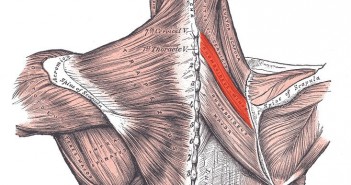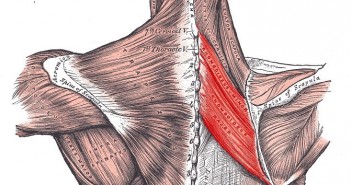The rhomboid major is a skeletal muscle on the back that connects the scapula (shoulder blade) with the vertebrae of the spinal column.
There are two rhomboid muscles; the rhomboid major and the rhomboid minor. Often simply called the rhomboids, they are rhombus-shaped muscles associated with the scapula (shoulder blade) and are chiefly responsible for its retraction.
The rhomboid major is located below (inferior to) the rhomboid minor. They act together to keep the scapula pressed against the thoracic wall.
The rhomboid major helps to hold the scapula (and thus the upper arm) onto the ribcage. Other muscles that perform this function include the serratus anterior and pectoralis minor.
The rhomboids also act to retract the scapula, pulling it towards the vertebral column.
The rhomboids work collectively with the levator scapulae muscles to elevate the medial border of the scapula, downwardly rotating the scapula. Antagonists to this function (upward rotators of the scapulae) are the serratus anterior and upper and lower fibres of the trapezius. If the lower fibres are inactive, the serratus anterior and upper trapezii work in tandem with the rhomboids and levators to elevate the entire scapula.
While other shoulder muscles are active, the rhomboids stabilise the scapula.
If you have any questions or comments about this or other articles on Golf Loopy, please send us an email.
You May Also Like…
Overview of a Great Golf Swing, which summarises the correct movements in a great golf swing.
Why is Having the Shoulders “Connected” So Important? Which explains how the shoulders enable the power of the big muscles in your legs and core to be transferred to the golf club.
Golf Anatomy and Kinesiology, a collection of articles describing the roles of the muscles involved in the golf swing.
The Role of the Levator Scapulae in the Golf Swing.
Trapezius muscle, which describes the large muscles between your neck and your shoulders.




